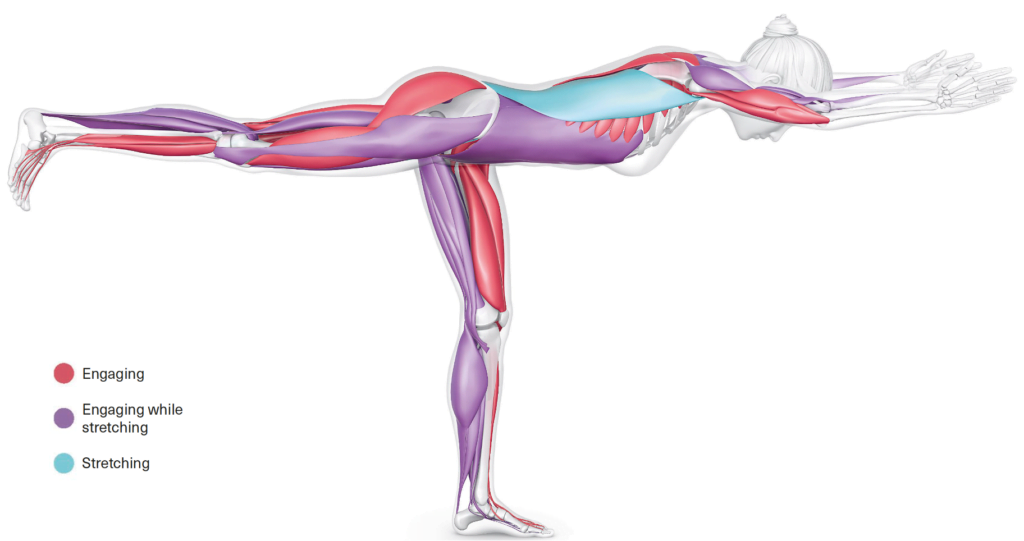Virabhadrasana III in Sanskrit, also known as Warrior 3, is named after the fierce warrior, Virabhadra. It is an intermediate balancing pose in yoga with dynamic standing posture. It requires a lot of focus to maintain a deliberate balance and all the muscles throughout the entire body such as the core, arms and legs need to be integrated together to stabilize in this pose. You can improve strength, stretch, stability, and concentration as you practice Warrior III pose. Let’s find out what is the magic that Virabhadrasana III pose impacts on your little muscles.
Pose type: Standing, Level: Intermediate, Target: Full Body
Chakras: Solar Plexus (Manipura Chakra), Sacral Chakra (Swadisthana Chakra), Root Chakra (Muladhara Chakra)

As illustrated in the above picture, when Warrior III is practiced, almost the whole physical anatomy is activated with a lot of engaging and stretching.
Anatomy
Lifted Leg
Concentric contraction (neutral hip extension and rotation)
- Hamstrings, addcutor magnus, gletus maximus
Standing Leg
Concentric contraction (neutral knee extension and balance on single leg)
- Articularis genu, quadriceps, intrinsic and extrinsic muscles of foot and lower leg
Eccentric contraction (hip flexion)
- Hamstrings
Eccentric contraction (lateral shift of pelvis over standing foot for balance)
- Gluteus medius and minimus, piriformis, superior and inferior gemellus
Upper body
Concentric contraction (rotation, abduction and elevation of scapula)
- Upper trapezius, serratus anterior
Concentric contraction (stabilisation and shoulder joint flexion)
- Rotator cuff, coracobranchialis, pectoralis major and minor, middle deltoid, biceps branchii
Concentric contraction (elbow extension)
- Anconeus, triceps branchii
Spine
Concentric contraction (maintain spine alignment)
- Intertransversarii, interspinalis, transversospinalis, erector spinae
Concentric contraction (prevent antierior tilt of pelvis and overextension of lumbar spine)
- Psoas minor, abdominal muscles

Physical Benefits
- Strengthen the shoulders and arms
- Tone the abdomen
- Strengthen hip flexors, glutes and legs
Health Benefits
- Good for digestion as the core is contracted
- Improve flexibility of the body
- Better concentration, mindfulness and clear the mind due to the focus on balancing
- Sharpen memory due to enhanced concentration power in long term
- Improve postures
Contraindications
Warrior III is not suitable for practitioners who have the following conditions:
- High blood pressure (For certain individuals, the pose’s abrupt increase in blood flow to the brain could lead to complications.)
- Serious back issue, Spondylitis
- Chronic leg, hip, back or shoulder injury
- Pregnant
References
- Yoga Anatomy by Leslie Kaminoff, Amy Matthews
- Science of Yoga by Ann Swanson
- https://www.fitsri.com/poses/warrior-3

